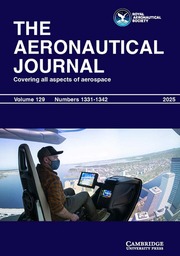Article contents
Integrated design of flight simulatormotion cueing systems
Published online by Cambridge University Press: 03 February 2016
Abstract
An advanced design process applicable to thespecification of flight simulator cueing systems ispresented in this paper. This process is based onthe analysis of the pilot-vehicle control loop byusing a pilot model incorporating both visual andvestibular feedback, and the aircraft dynamics.After substituting the model for the simulatedaircraft, the analysis tools are used to adjust thewashout filter parameters with the goal of restoringpilot control behaviour. This process allows thespecification of the motion cueing algorithm. Then,based on flight files representative of theoperational flight envelope, the required motionsystem space is determined. The motion-base geometryis established based on practical limitations, aswell as criteria for the stability of the platformwith respect to singular conditions. With thisprocess the characteristics of the aircraft, thetasks to be simulated, and the missions themselvesare taken into account in defining the simulatormotion cueing system.
Information
- Type
- Research Article
- Information
- Copyright
- Copyright © Royal Aeronautical Society 2005
References
- 8
- Cited by

